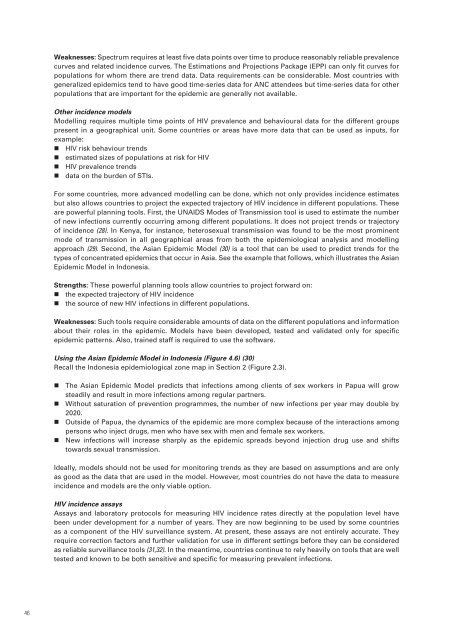Guidelines for second generation HIV surveillance - World Health ...
Guidelines for second generation HIV surveillance - World Health ...
Guidelines for second generation HIV surveillance - World Health ...
Create successful ePaper yourself
Turn your PDF publications into a flip-book with our unique Google optimized e-Paper software.
Weaknesses: Spectrum requires at least five data points over time to produce reasonably reliable prevalence<br />
curves and related incidence curves. The Estimations and Projections Package (EPP) can only fit curves <strong>for</strong><br />
populations <strong>for</strong> whom there are trend data. Data requirements can be considerable. Most countries with<br />
generalized epidemics tend to have good time-series data <strong>for</strong> ANC attendees but time-series data <strong>for</strong> other<br />
populations that are important <strong>for</strong> the epidemic are generally not available.<br />
Other incidence models<br />
Modelling requires multiple time points of <strong>HIV</strong> prevalence and behavioural data <strong>for</strong> the different groups<br />
present in a geographical unit. Some countries or areas have more data that can be used as inputs, <strong>for</strong><br />
example:<br />
• <strong>HIV</strong> risk behaviour trends<br />
• estimated sizes of populations at risk <strong>for</strong> <strong>HIV</strong><br />
• <strong>HIV</strong> prevalence trends<br />
• data on the burden of STIs.<br />
For some countries, more advanced modelling can be done, which not only provides incidence estimates<br />
but also allows countries to project the expected trajectory of <strong>HIV</strong> incidence in different populations. These<br />
are powerful planning tools. First, the UNAIDS Modes of Transmission tool is used to estimate the number<br />
of new infections currently occurring among different populations. It does not project trends or trajectory<br />
of incidence (28). In Kenya, <strong>for</strong> instance, heterosexual transmission was found to be the most prominent<br />
mode of transmission in all geographical areas from both the epidemiological analysis and modelling<br />
approach (29). Second, the Asian Epidemic Model (30) is a tool that can be used to predict trends <strong>for</strong> the<br />
types of concentrated epidemics that occur in Asia. See the example that follows, which illustrates the Asian<br />
Epidemic Model in Indonesia.<br />
Strengths: These powerful planning tools allow countries to project <strong>for</strong>ward on:<br />
• the expected trajectory of <strong>HIV</strong> incidence<br />
• the source of new <strong>HIV</strong> infections in different populations.<br />
Weaknesses: Such tools require considerable amounts of data on the different populations and in<strong>for</strong>mation<br />
about their roles in the epidemic. Models have been developed, tested and validated only <strong>for</strong> specific<br />
epidemic patterns. Also, trained staff is required to use the software.<br />
Using the Asian Epidemic Model in Indonesia (Figure 4.6) (30)<br />
Recall the Indonesia epidemiological zone map in Section 2 (Figure 2.3).<br />
• The Asian Epidemic Model predicts that infections among clients of sex workers in Papua will grow<br />
steadily and result in more infections among regular partners.<br />
• Without saturation of prevention programmes, the number of new infections per year may double by<br />
2020.<br />
• Outside of Papua, the dynamics of the epidemic are more complex because of the interactions among<br />
persons who inject drugs, men who have sex with men and female sex workers.<br />
• New infections will increase sharply as the epidemic spreads beyond injection drug use and shifts<br />
towards sexual transmission.<br />
Ideally, models should not be used <strong>for</strong> monitoring trends as they are based on assumptions and are only<br />
as good as the data that are used in the model. However, most countries do not have the data to measure<br />
incidence and models are the only viable option.<br />
<strong>HIV</strong> incidence assays<br />
Assays and laboratory protocols <strong>for</strong> measuring <strong>HIV</strong> incidence rates directly at the population level have<br />
been under development <strong>for</strong> a number of years. They are now beginning to be used by some countries<br />
as a component of the <strong>HIV</strong> <strong>surveillance</strong> system. At present, these assays are not entirely accurate. They<br />
require correction factors and further validation <strong>for</strong> use in different settings be<strong>for</strong>e they can be considered<br />
as reliable <strong>surveillance</strong> tools (31,32). In the meantime, countries continue to rely heavily on tools that are well<br />
tested and known to be both sensitive and specific <strong>for</strong> measuring prevalent infections.<br />
46
















